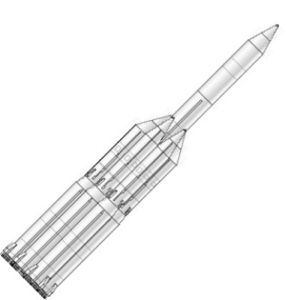
Home - Search - Browse - Alphabetic Index: 0- 1- 2- 3- 4- 5- 6- 7- 8- 9
A- B- C- D- E- F- G- H- I- J- K- L- M- N- O- P- Q- R- S- T- U- V- W- X- Y- Z
SK-100
 SK-100 SK-100 launch vehicle, a cluster of R-16's Credit: © Mark Wade |
Status: Cancelled 1962. Payload: 100,000 kg (220,000 lb). Gross mass: 2,000,000 kg (4,400,000 lb). Height: 55.00 m (180.00 ft). Diameter: 30.00 m (98.00 ft). Apogee: 200 km (120 mi).
The SK-100 first stage was to consist of six R-16 first stages, clustered around a single R-16 first stage as the second stage / vehicle core. The third stage would be derived from the R-16 second stage. Lift-off mass would have been 2,000 metric tons.
While superficially attractive, this cluster concept would have resulted in 24 first stage engine chambers firing simultaneously (4 chambers per stage x 6 stages). Failure of a single chamber could be catastrophic. Furthermore the clustered stages presented complex dynamic interaction and resonance problems. Another new technical challenge was zero-G start-up of the second stage. Propellant settling prior to engine ignition was solved by using ullage motors. These liquid fuel engines were pressure-fed using diaphragm-contained propellants. This 'low thrust system' would find application in later Yangel missile designs.
Work on the SK-100 reached the point of testing of a sub-scale dynamic model, and detailed design of the inter-stage structural elements and engine feed plumbing. But Yangel, noting the 'gigantomania' that was driving Korolev, Chelomei, and Glushko to propose ever more complex super-booster designs, decided to 'go back to the drawing board' with a clean sheet of paper. The result would be the R-56, a third way to large booster design between that of Chelomei's UR-700 and Korolev's N1.
LEO Payload: 100,000 kg (220,000 lb) to a 200 km orbit at 52.00 degrees.
Family: heavy-lift, orbital launch vehicle. Country: Ukraine. Agency: Yuzhnoye. Bibliography: 417.
Back to top of page
Home - Search - Browse - Alphabetic Index: 0- 1- 2- 3- 4- 5- 6- 7- 8- 9
A- B- C- D- E- F- G- H- I- J- K- L- M- N- O- P- Q- R- S- T- U- V- W- X- Y- Z
© 1997-2019 Mark Wade - Contact
© / Conditions for Use